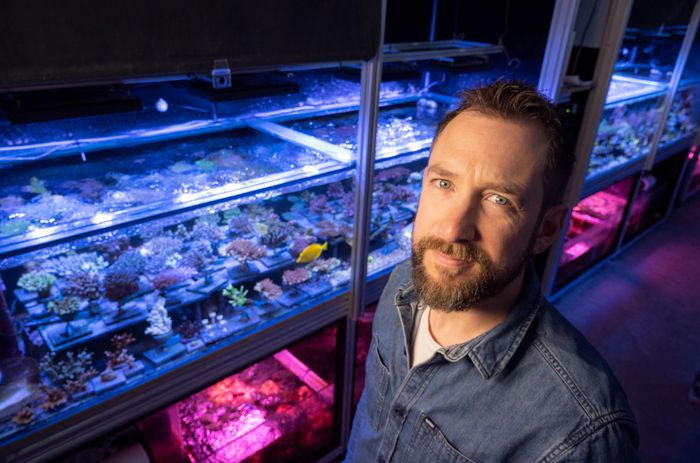You wouldn’t expect coral-reef research to be taking place in a broom cupboard. But that’s what we’re doing at the Horniman Museum and Gardens in London. The museum was built in 1901 and has botanical gardens, collections devoted to natural history, anthropology, music — and a tiny aquarium space that I can sprint around in 12 seconds.
Our research space is even smaller: just a cupboard room under a staircase, and the cramped corridor shown here. We almost have to think like yacht builders to maximize it, and we wear red headlamps to work in this tight, dark area.
My main research interest is the reproductive biology of reef-building corals, which reproduce only a couple of times a year. Before 2010, no one knew how best to replicate in an aquarium what triggers corals to spawn in the wild. Because we’re losing coral reefs through climate change, we wanted to know whether we could collect eggs and sperm in the wild, produce test-tube-baby corals and then put them back onto reefs that have been damaged.
I went to Singapore in 2010, and to Guam in 2013 and 2014, to witness mass spawning events and collect samples. You have just 15 minutes once a year, after a particular full moon, to capture such events. The team I was with worked at night, battered by waves and surrounded by jellyfish.
Our task has been to work out how to simulate these conditions in the aquarium. We use global data sets of temperature cycles, daylight hours and lunar cycles to give the corals the environment they would experience in the wild. Baby corals are very vulnerable because they are just a few millimetres in size and have weak defences. We want to scale up the endeavour, so that reseeded corals will survive in wild reefs.
We are losing coral reefs so fast, and one-third of all ocean species reside in these habitats. Working in the reefs is depressing. But working in restoration is heartening.






